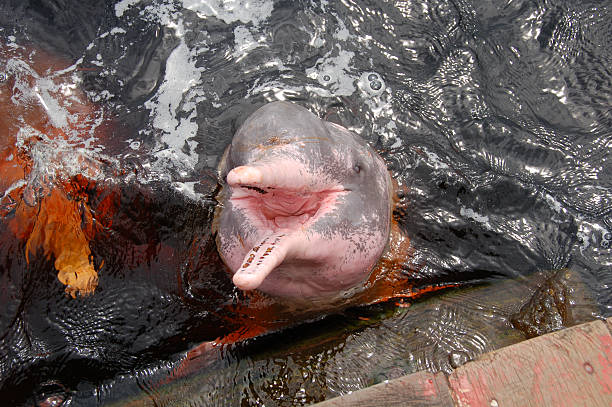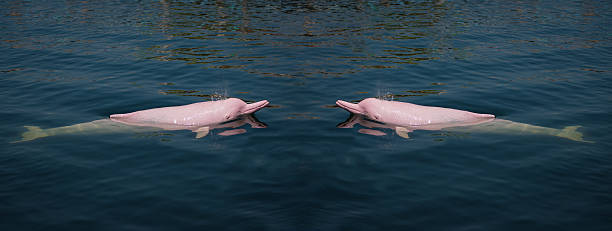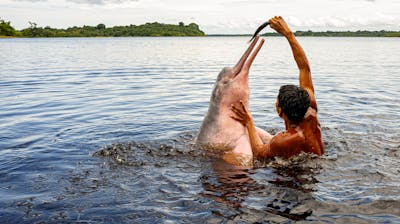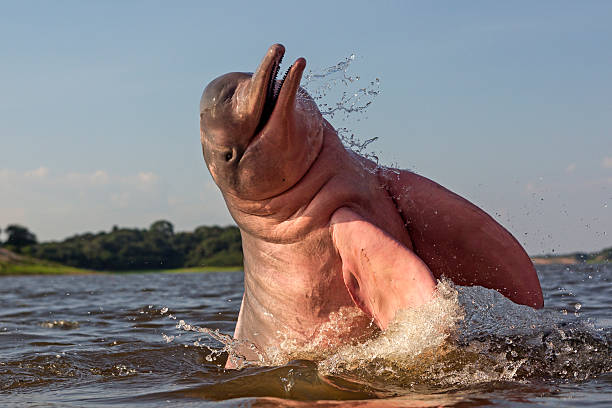Table of Contents
Scientific Classification
| Kingdom | Animalia |
| Phylum | Chordata |
| Class | Mammalia |
| Order | Artiodactyla |
| Family | Iniidae |
| Genus | Inia |
| Species | Inia geoffrensis |
| Scientific Name | Inia geoffrensis |
Description
The Amazon River Dolphin, also known as boto (Inia geoffrensis), is a distinctive freshwater dolphin. Their bodies are more flexible due to their unfused vertebrae, which allows them to navigate through challenging underwater environments, such as flooded forests.
Adult Amazon River Dolphins can grow up to 2.5 meters (8.2 feet) in length and can weigh as much as 185 kg (408 lbs). They possess long snouts equipped with conical teeth, which are ideal for catching slippery prey. Although their eyes are relatively small, they are quite effective, enabling them to see well in murky waters. Unlike their marine counterparts, botos do not have a dorsal fin; instead, they feature a ridge along their back.

Distribution
Amazon River Dolphins inhabit South America, primarily residing in the extensive river systems of the:
Amazon River Basin (Brazil, Peru, Colombia, Ecuador, and Bolivia)
Orinoco River Basin (Venezuela and Colombia)
While these dolphins can be found in various locations, they are seldom seen by people. Their preference for secluded freshwater regions makes them difficult to spot.
Habitat
Amazon River Dolphins are found in a variety of freshwater ecosystems, such as:
Rivers, typically located in large river basins like the Amazon and Orinoco.
Flooded Forests – In the wet season, these dolphins navigate through submerged forests in search of food.
Lakes and Tributaries – Smaller bodies of water offer extra hunting opportunities and places to take refuge.
They are highly adaptable to fluctuating water conditions, moving seamlessly between deep and shallow areas.

Diet
Amazon River Dolphins are carnivorous and primarily eat a variety of foods, including:
Fish – They consume over 50 different species, such as catfish and piranhas.
Crustaceans – This includes freshwater crabs.
Small Aquatic Creatures – They occasionally feed on turtles and smaller amphibians.
With their long snouts and flexible necks, they can reach into crevices, allowing them to catch prey that may be hiding in plants or under debris.
Behavior
These dolphins display intelligent and social behaviors, including:
Solitary and Group Living – Amazon River Dolphins typically live either alone or in small groups, which sets them apart from ocean dolphins.
Playfulness – They enjoy playing with one another and with objects like floating logs.
Echolocation – This skill is essential for navigation and hunting, particularly in murky waters.
Vocal Communication – They use clicking and whistling sounds to interact with their environment.
While they appreciate solitude, they occasionally join forces to hunt, especially when prey is abundant.

Lifespan
Amazon River Dolphins can live for as long as 30 years in the wild. However, their lifespan tends to decrease in captivity due to stress and inadequate living conditions. Freshwater dolphins possess a slower metabolism and unique characteristics that enable them to thrive longer than their marine counterparts in their specific environments.
Reproduction and Lifecycle
Amazon River Dolphins reproduce slowly, so conservation efforts are even more important.
Mating Season – Occurs during the wet season when food is abundant.
Gestation Period – Lasts approximately 11 to 15 months.
Birth – A single calf is born, measuring around 80 cm (31 inches) in length and weighing about 10 kg (22 lbs).
Maternal Care – Calves depend on their mothers for nearly two years. They nurse and learn key survival skills during this time.
Sexual Maturity – Reached between 6 to 10 years of age.
Because they reproduce slowly, their populations are especially at risk from environmental threats.
Predators
Amazon River Dolphins have few natural predators, but threats include:
Jaguar and Caiman Attacks – Rare, but possible in shallow waters.
Piranhas – While not a direct threat, injured dolphins may attract opportunistic attacks.
Humans – The biggest threat due to habitat destruction, pollution, and fishing practices.
Adaptations
The Amazon River Dolphin has evolved remarkable adaptations for freshwater survival:
Flexible Necks – Their vertebrae aren’t fused, so they can turn their heads freely. This is different from marine dolphins.
Pink Pigmentation – Blood vessels near the skin’s surface help regulate body temperature.
Echolocation – Highly developed sonar assists in hunting in turbid waters.
Dorsal Ridge Instead of Fin – Helps navigate dense underwater vegetation.
Sharp Teeth and Long Snout – Ideal for catching fish in narrow crevices.
These unique traits make them well-suited for the challenges of the Amazonian waterways.
Conservation Status
The Amazon River Dolphin is listed as Endangered by the IUCN because of various threats.
Threats:
Pollution – Mercury contamination from gold mining severely impacts their health.
Fishing Conflicts – They are often killed or injured by fishing nets.
Deforestation – Habitat loss from agriculture and logging reduces their living space.
Hunting – In some regions, they are hunted for use as bait in fisheries.
Conservation Efforts:
Protected Reserves – Establishment of conservation areas and national parks.
Legislation – Some South American countries have laws protecting these dolphins.
Ecotourism Initiatives – Encouraging sustainable tourism to raise awareness.
Scientific Research – Studies on their behavior and threats to enhance conservation strategies.
Conclusion
The Amazon River Dolphin is a remarkable species that plays a crucial role in maintaining the ecological balance of the Amazon basin. Unfortunately, they are increasingly threatened by human activities. Therefore, it is essential that we take swift action to protect them and secure their future.
By safeguarding these distinctive freshwater dolphins, we not only preserve an irreplaceable species but also contribute to the health of the Amazon’s diverse ecosystem.



